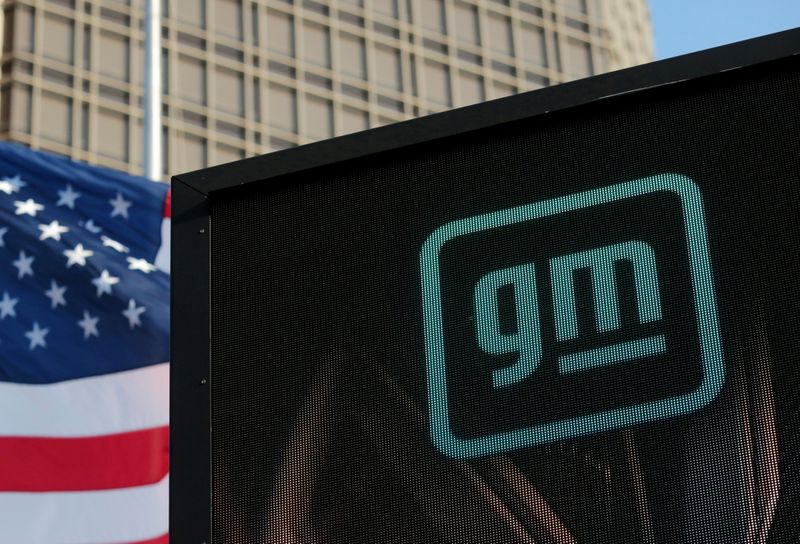Intel stock extends gains after report of possible U.S. government stake
Introduction & Market Context
General Motors (NYSE:GM) reported solid first-quarter 2025 results on May 1, showing continued market share gains and operational strength, but significantly reduced its full-year guidance due to anticipated tariff impacts. The automaker delivered adjusted earnings per share of $2.78, up from $2.62 in the same quarter last year, despite a slight decline in adjusted EBIT.
The company’s stock, which had already experienced volatility following its Q4 2024 earnings release when it fell 9.36% despite beating forecasts, was trading up 2.79% in pre-market at $46.50 following the Q1 announcement.
Quarterly Performance Highlights
GM reported Q1 2025 revenue of $44.0 billion with an adjusted EBIT of $3.5 billion, resulting in an EBIT-adjusted margin of 7.9%. While revenue increased, the EBIT-adjusted figure declined from $3.9 billion (9.0% margin) in Q1 2024. The company maintained its adjusted automotive free cash flow at $0.8 billion.
As shown in the following comprehensive performance overview:
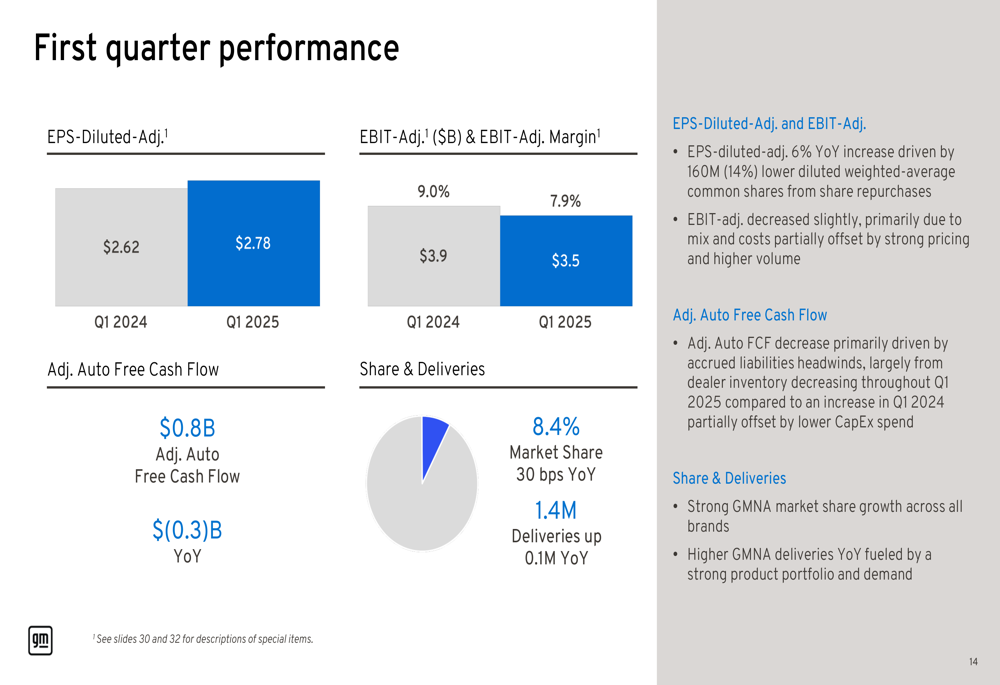
The 6% year-over-year increase in adjusted EPS to $2.78 was primarily driven by a 14% reduction in diluted weighted-average common shares from share repurchases, offsetting the slight decrease in EBIT-adjusted. The company noted that EBIT-adjusted decreased primarily due to mix and costs, partially offset by strong pricing and higher volume.
A detailed breakdown of the changes in EBIT-adjusted performance reveals the specific factors affecting results:
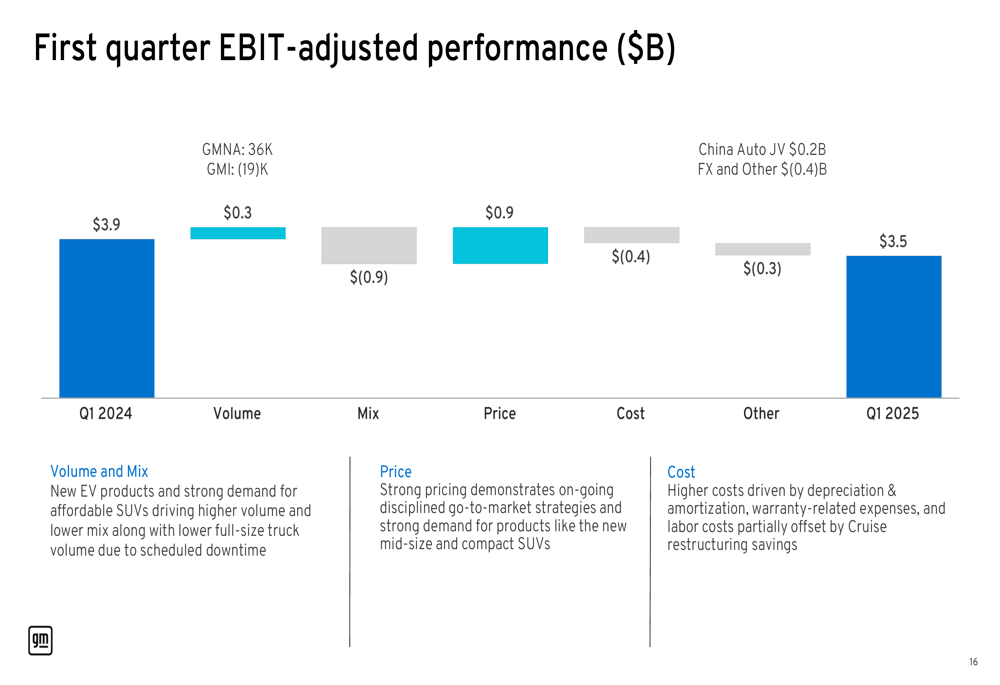
Strong pricing contributed $0.9 billion to EBIT-adjusted, demonstrating ongoing disciplined go-to-market strategies and strong demand for products like the new mid-size and compact SUVs. However, this was offset by negative mix impact of $0.9 billion and higher costs of $0.4 billion driven by depreciation, amortization, warranty-related expenses, and labor costs.
Market Position & Product Performance
GM reported significant market share gains across its portfolio. U.S. market share reached 17.2%, up 1.8 percentage points year-over-year, with the company claiming it’s gaining share three times faster than its closest competitor while maintaining low incentives.
The company’s SUV lineup delivered particularly strong results, with refreshed full-size SUVs seeing their best Q1 sales since 2007. The Tahoe, Suburban, and Yukon models achieved a combined market share of 69%, while Cadillac Escalade had a record Q1, including the new all-electric ESCALADE IQ.
Mid-size SUVs also showed impressive growth, with Chevrolet Traverse sales up 62%, GMC Acadia up 73%, and Buick Enclave up 37% year-over-year. The company noted these new models are delivering higher profitability than their outgoing counterparts.
EV Strategy & Performance
GM maintained its position as the second-largest EV seller in the U.S. market, with Q1 EV sales up 94% year-over-year and a 10.4% U.S. market share. The company highlighted Chevrolet as "the industry’s fastest growing EV brand," driven by the Equinox EV and Blazer EV.
The following chart illustrates GM’s North American performance, including EV sales growth:
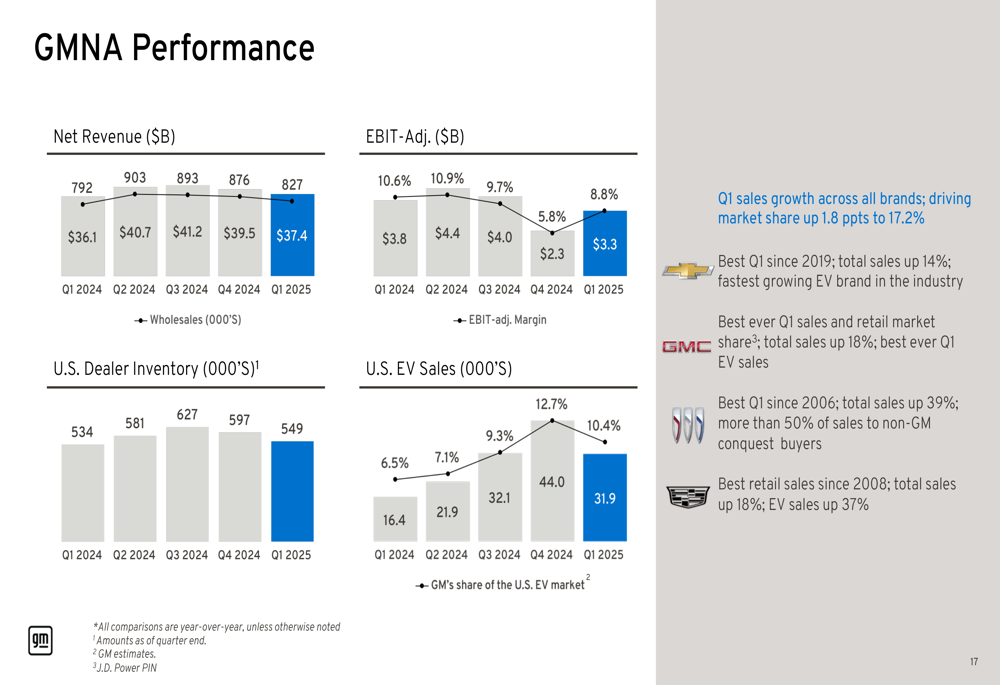
The company reported strong conquest rates, with approximately 60% of GM’s EV buyers trading in non-GM vehicles, rising to around 70% for the Cadillac LYRIQ. GMC EV sales increased 183% in Q1, driven by the Sierra and Hummer EVs.
Cadillac’s EV adoption rate of approximately 20% of U.S. sales significantly outpaces the broader industry, with the company noting that U.S. EV adoption is much stronger in the luxury segment (14%) compared to the total industry (8%).
Regional Performance
GM North America (GMNA) delivered an EBIT-adjusted of $3.3 billion with an 8.8% margin, down from $3.8 billion (10.6% margin) in Q1 2024. The company attributed this to higher costs and vehicle mix, partially offset by higher wholesale units and strong pricing.
A segment breakdown of EBIT-adjusted performance shows the contribution from each region:
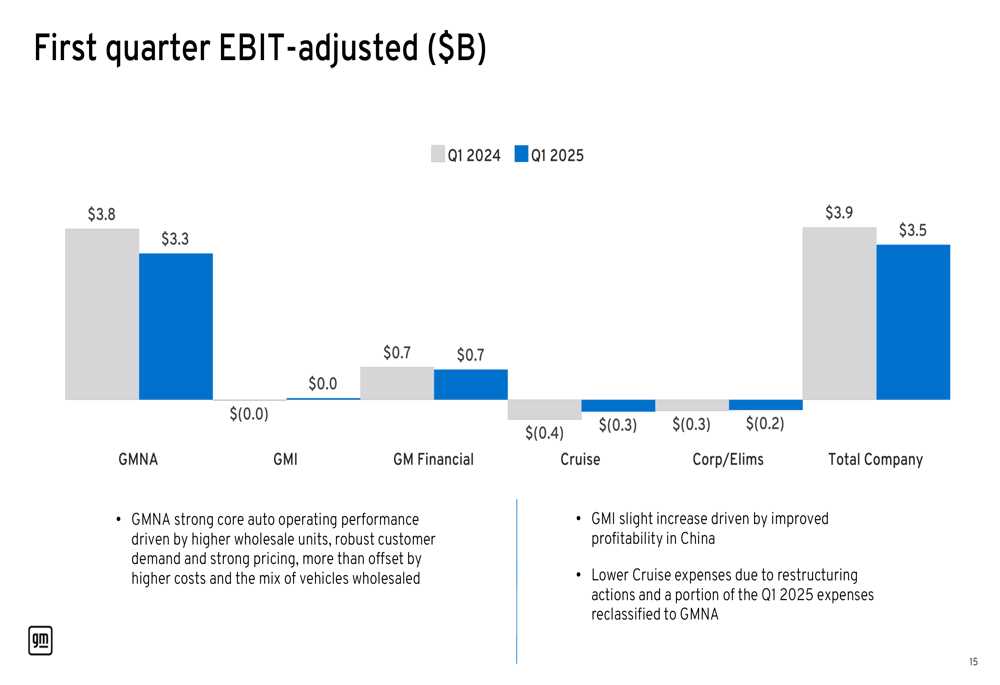
In a positive development, GM’s China joint venture returned to profitability in Q1 2025 after several quarters of losses, reporting a small positive equity income with a 1.4% margin. This improvement was driven by strong sales, improved vehicle profitability, and benefits from restructuring actions. Sales of New Energy Vehicles (NEVs) in China increased over 50% year-over-year due to new product offerings.
Strategic Initiatives
GM highlighted several strategic initiatives, including the expansion of its Super Cruise enhanced driver assistance system. The number of Super Cruise-enabled vehicles on the road increased by approximately 230,000 units year-over-year in Q1, representing more than 100% growth. The system won the 2025 MotorTrend Best Tech Award and is now offered on a broader range of full and mid-size SUVs, while being standard on almost all Cadillac EVs.
The company also emphasized its acceleration of AI integration across the enterprise, appointing a Chief AI Officer and forming strategic partnerships with industry leaders like NVIDIA (NASDAQ:NVDA) to drive AI advancements in manufacturing, virtual testing, and vehicle connectivity.
GM stressed its strong American manufacturing and engineering footprint, noting it employs more people in the U.S. than any other automaker, with over 85% of its global R&D and engineering performed in the U.S. The company operates 11 assembly plants in the U.S., more than any other automaker, and has limited dependence on China, with less than 3% of direct material purchases for U.S. production sourced from China.
Updated Guidance & Tariff Impact
The most significant news from the presentation was GM’s substantial reduction in its 2025 guidance, primarily due to anticipated tariff impacts. The company now expects:
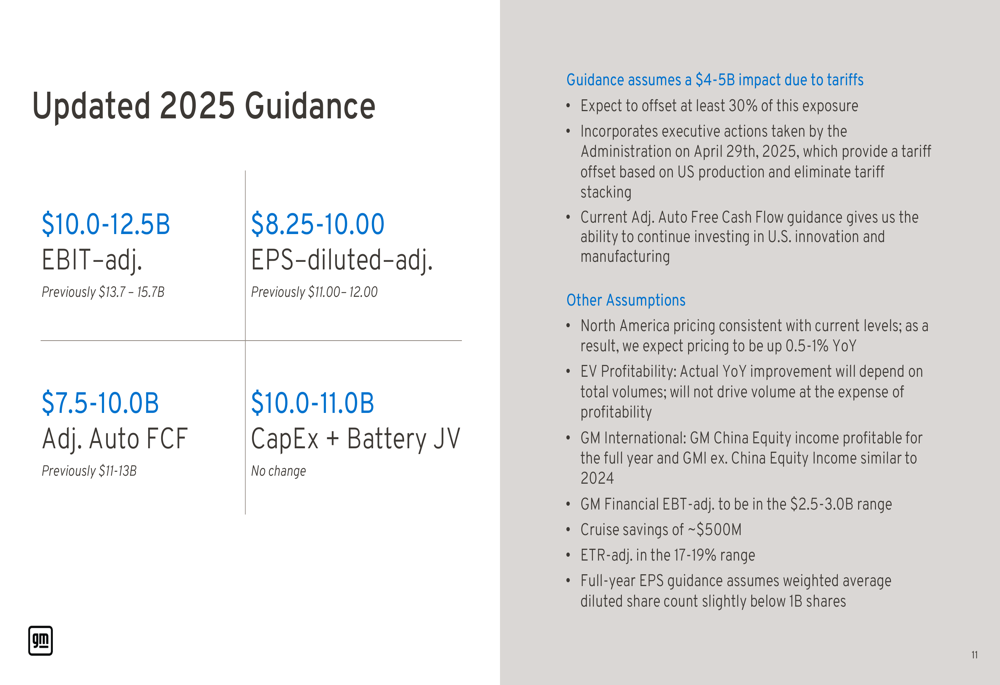
The updated guidance represents a significant reduction from the previous outlook provided in Q4 2024, which projected EBIT-adjusted of $13.7-15.7 billion and EPS-diluted-adjusted of $11.00-12.00. GM attributed this reduction to an expected $4-5 billion impact from tariffs, though it noted it expects to offset at least 30% of this exposure.
The guidance incorporates executive actions taken by the Administration on April 29, 2025, which provide a tariff offset based on U.S. production and eliminate tariff stacking. Despite these challenges, the company stated its adjusted automotive free cash flow guidance gives it "the ability to continue investing in U.S. innovation and manufacturing."
Capital Allocation & Liquidity
GM reported returning $2.1 billion to shareholders through dividends and share repurchases in Q1 2025, while also paying off $0.5 billion of senior notes in April. However, the company announced it is "pausing additional share repurchases until we have more certainty with respect to our operating environment," though it ended Q1 with $4.3 billion of remaining authorization.
The company’s automotive liquidity stood at $32.8 billion as of March 31, 2025, down from $35.5 billion at the end of 2024, while total automotive debt remained relatively stable at $15.6 billion.
The following reconciliation details the components of GM’s adjusted automotive free cash flow:
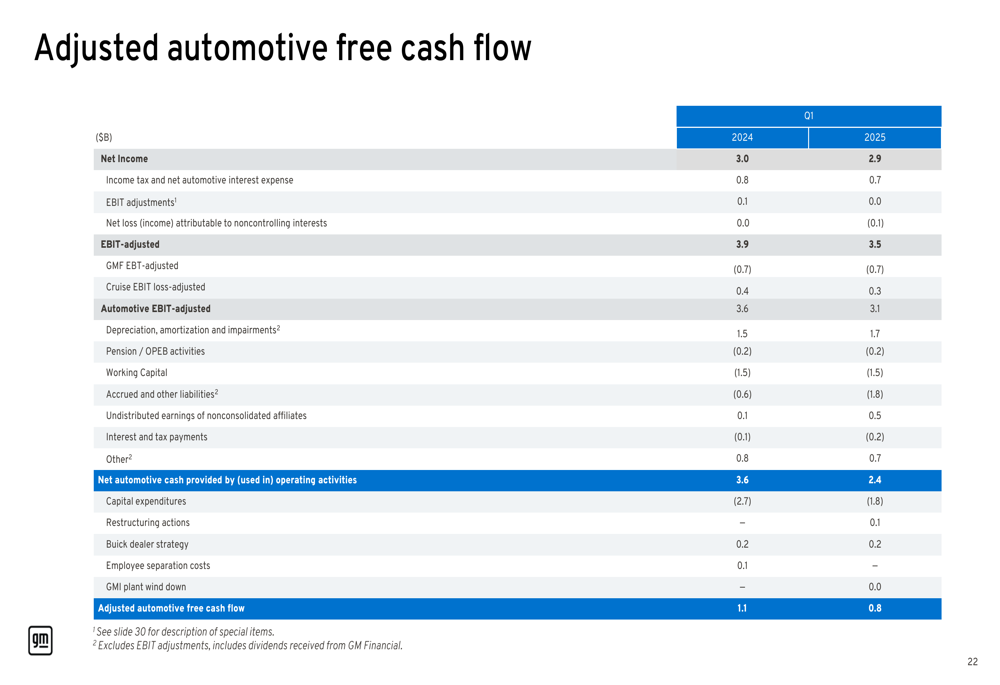
Outlook & Conclusion
Despite the significant guidance reduction, GM emphasized several strengths that position it to navigate the challenging environment. The company highlighted its diverse portfolio spanning both internal combustion engine vehicles and EVs, strong U.S. manufacturing footprint, and disciplined financial approach.
GM’s Q1 2025 results demonstrate the company’s ability to execute effectively in its core business while gaining market share in both traditional and electric vehicle segments. However, the substantial guidance reduction due to tariff impacts underscores the significant external challenges facing the automotive industry.
The company’s pause on share repurchases signals a more cautious approach to capital allocation amid uncertainty, though GM maintains it will continue investing in U.S. innovation and manufacturing. As the company navigates these headwinds, its return to profitability in China and continued market share gains provide some positive counterbalance to the tariff-related challenges ahead.
Full presentation:
This article was generated with the support of AI and reviewed by an editor. For more information see our T&C.
